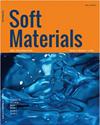氢化h-BN纳米片热导率的反作用力场研究
IF 1.4
4区 材料科学
Q4 MATERIALS SCIENCE, MULTIDISCIPLINARY
引用次数: 0
摘要
摘要采用分子动力学模拟方法研究了氢化六方氮化硼(h-BN)纳米片的热导率。使用了氢和h-BN相互作用的新参数化反作用力场(ReaxFF)。使用ReaxFF是因为与其他更简单的原子间势相比,它的精度更高。单层h-BN纳米片的精确厚度选择已被证明对原始扶手椅和锯齿形纳米片产生高导热值。进一步发现氢化降低了氢化h-BN纳米片的热导率。这种热导率的降低是由于当氢原子置于B和N原子之上时发生sp2到sp3键合转变。由于在较高温度下出现声子-声子散射,温度的升高也会降低热导率。与B空位缺陷相比,N空位缺陷显示出更低的热导率。此外,去除更多的原子会导致热导率的更高下降。然而,沿垂直方向构建的空位缺陷提供了热导率的最高降低。预计这项工作将为使用这些新型h-BN纳米片设计有效的储氢系统提供有用的见解。本文章由计算机程序翻译,如有差异,请以英文原文为准。
Thermal conductivity of hydrogenated h-BN nanosheets: a reactive force field study
ABSTRACT Thermal conductivity of hydrogenated hexagonal boron nitride (h-BN) nanosheets was investigated using molecular dynamics simulation method. A newly parameterized reactive force field (ReaxFF) for hydrogen and h-BN interactions was used. ReaxFF was used due to its higher accuracy compared to other simpler interatomic potentials. Accurate thickness selection of a monolayer h-BN nanosheet has been shown to produce high thermal conductivity values for pristine armchair and zigzag nanosheets. It was further found that hydrogenation diminishes thermal conductivity of hydrogenated h-BN nanosheets. This reduction in thermal conductivity was due to the occurrence of sp2 to sp3 bonding transition when hydrogen atoms were placed on top of B and N atoms. The increase in temperature was also found to diminish thermal conductivity due to the occurrence of phonon–phonon scattering at higher temperatures. N-vacancy defect has then been shown to exhibit lower thermal conductivity compared to B-vacancy defect. Furthermore, the removal of more atoms contributes to higher decline in thermal conductivity. However, vacancy defect constructed along vertical direction provides the highest reduction in thermal conductivity. It is expected that this work provides useful insights for the design of an effective hydrogen storage system using these novel h-BN nanosheets.
求助全文
通过发布文献求助,成功后即可免费获取论文全文。
去求助
来源期刊

Soft Materials
工程技术-材料科学:综合
CiteScore
2.90
自引率
0.00%
发文量
21
审稿时长
2.2 months
期刊介绍:
Providing a common forum for all soft matter scientists, Soft Materials covers theory, simulation, and experimental research in this rapidly expanding and interdisciplinary field. As soft materials are often at the heart of modern technologies, soft matter science has implications and applications in many areas ranging from biology to engineering.
Unlike many journals which focus primarily on individual classes of materials or particular applications, Soft Materials draw on all physical, chemical, materials science, and biological aspects of soft matter. Featured topics include polymers, biomacromolecules, colloids, membranes, Langmuir-Blodgett films, liquid crystals, granular matter, soft interfaces, complex fluids, surfactants, gels, nanomaterials, self-organization, supramolecular science, molecular recognition, soft glasses, amphiphiles, foams, and active matter.
Truly international in scope, Soft Materials contains original research, invited reviews, in-depth technical tutorials, and book reviews.
 求助内容:
求助内容: 应助结果提醒方式:
应助结果提醒方式:


